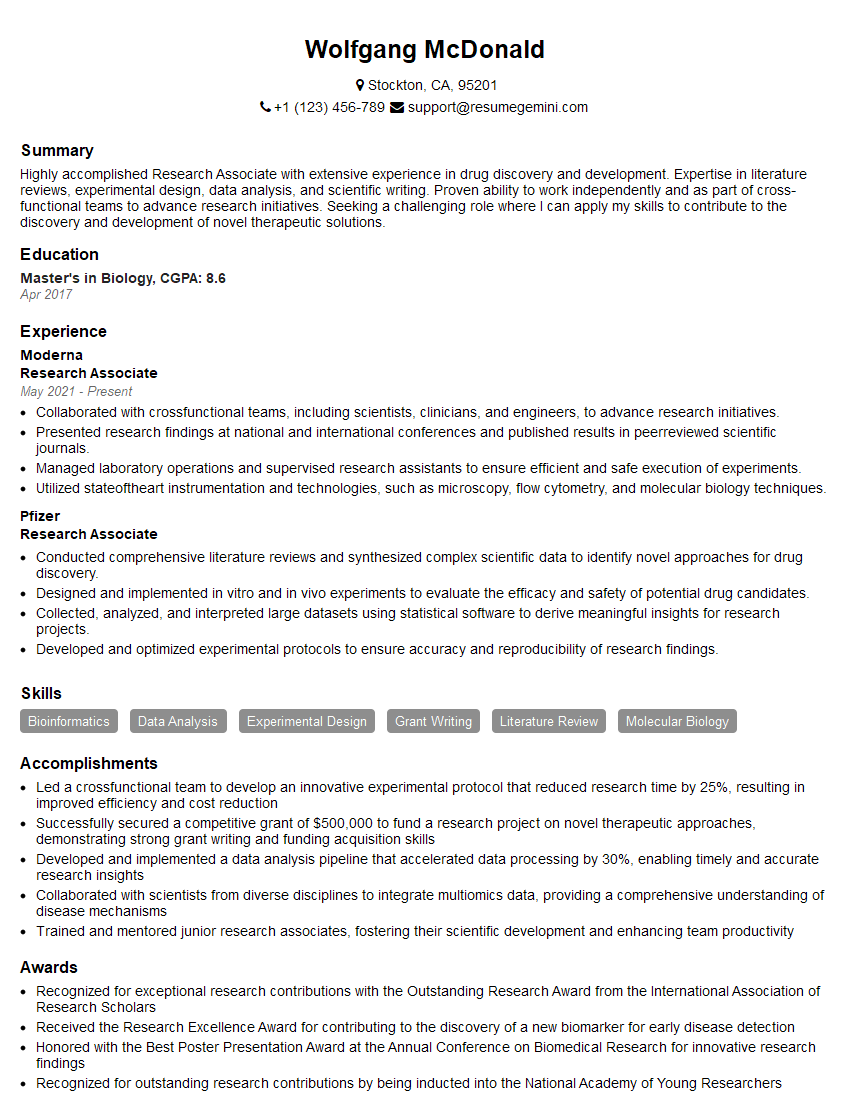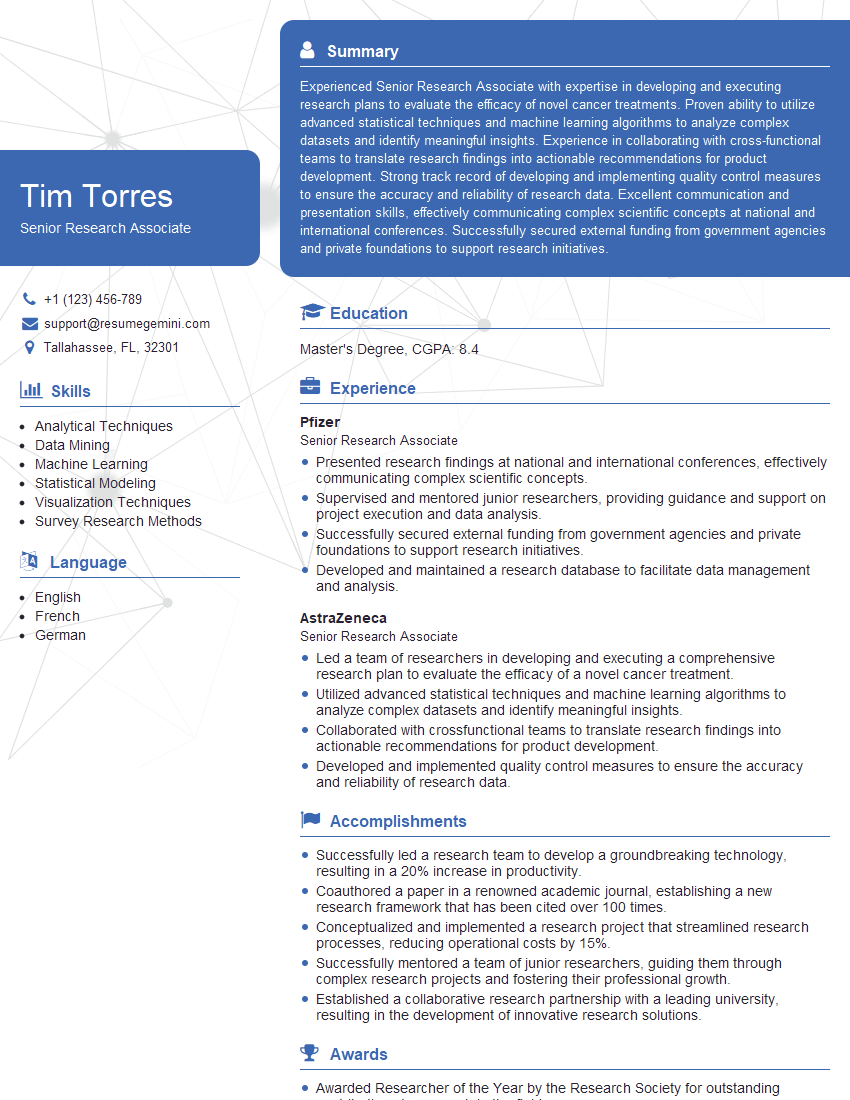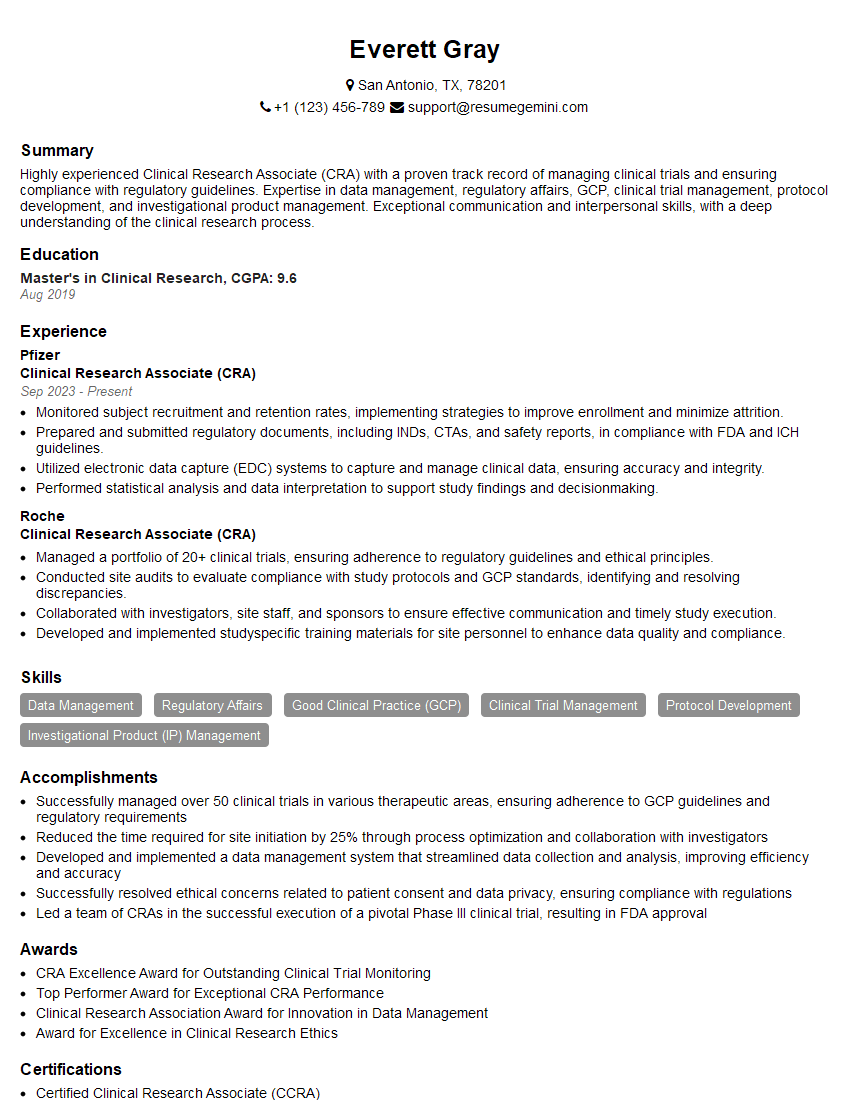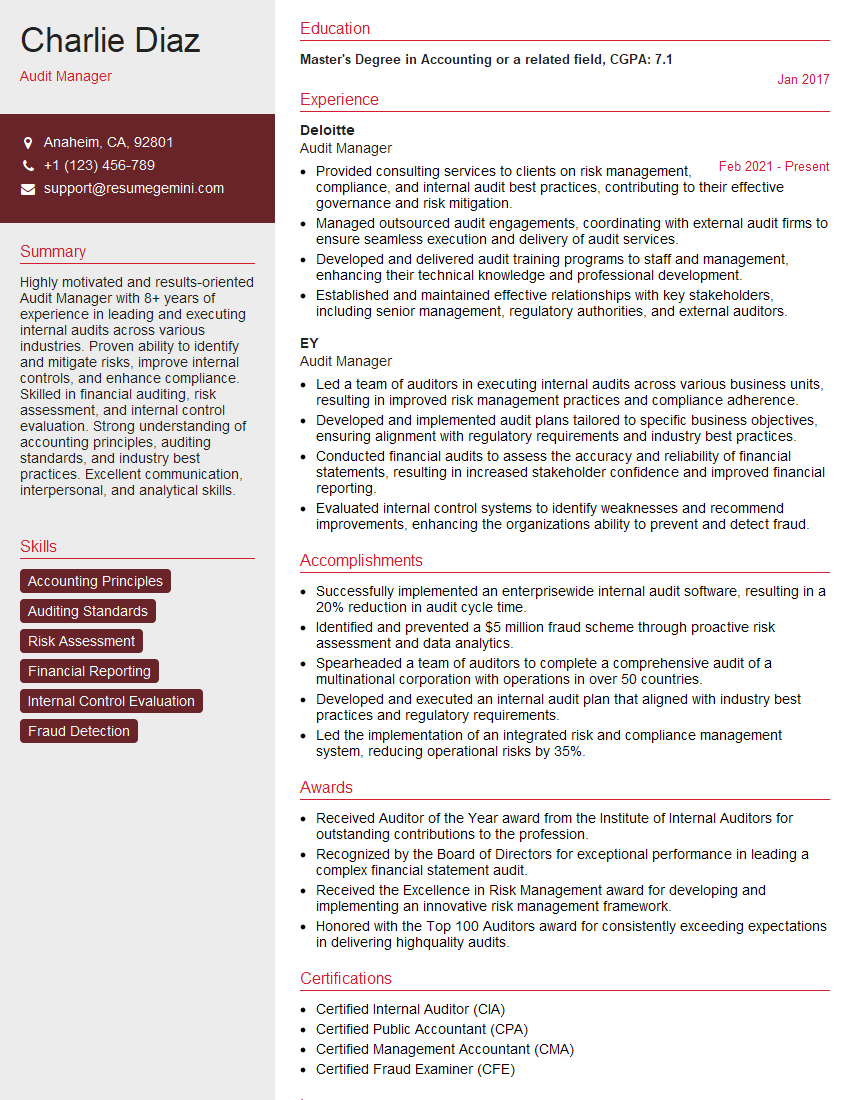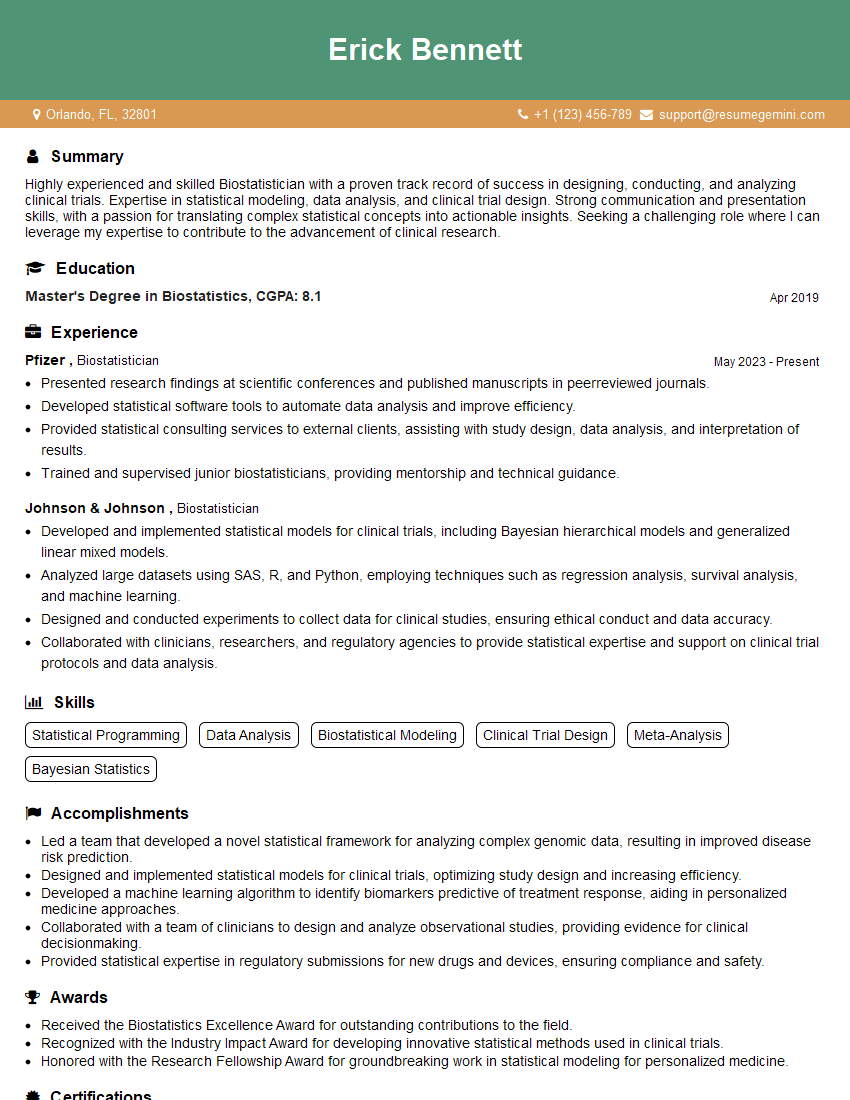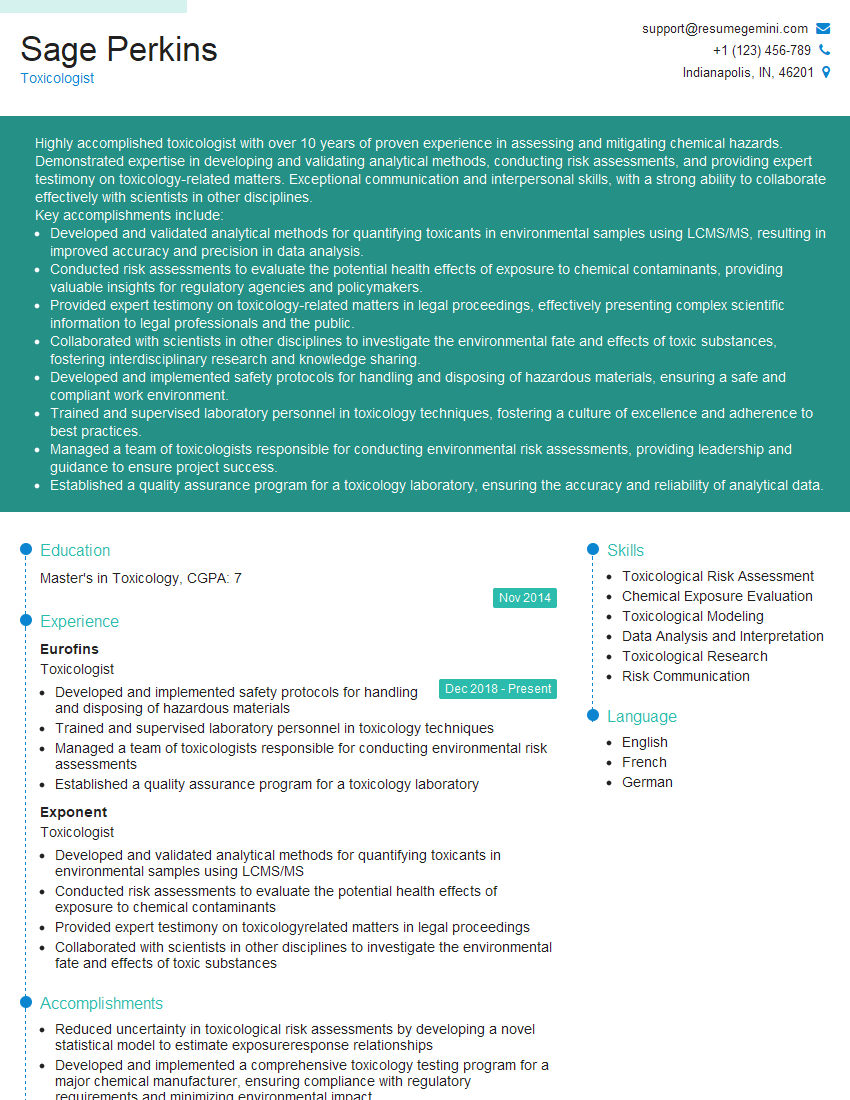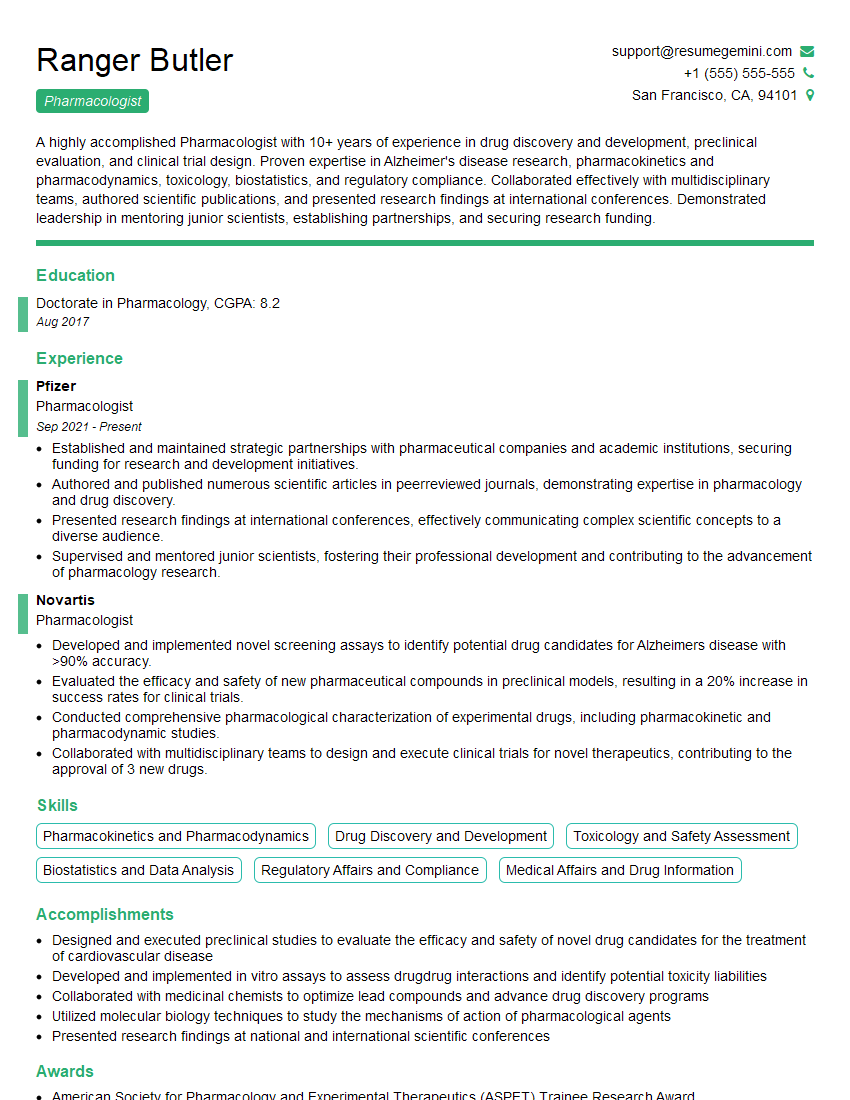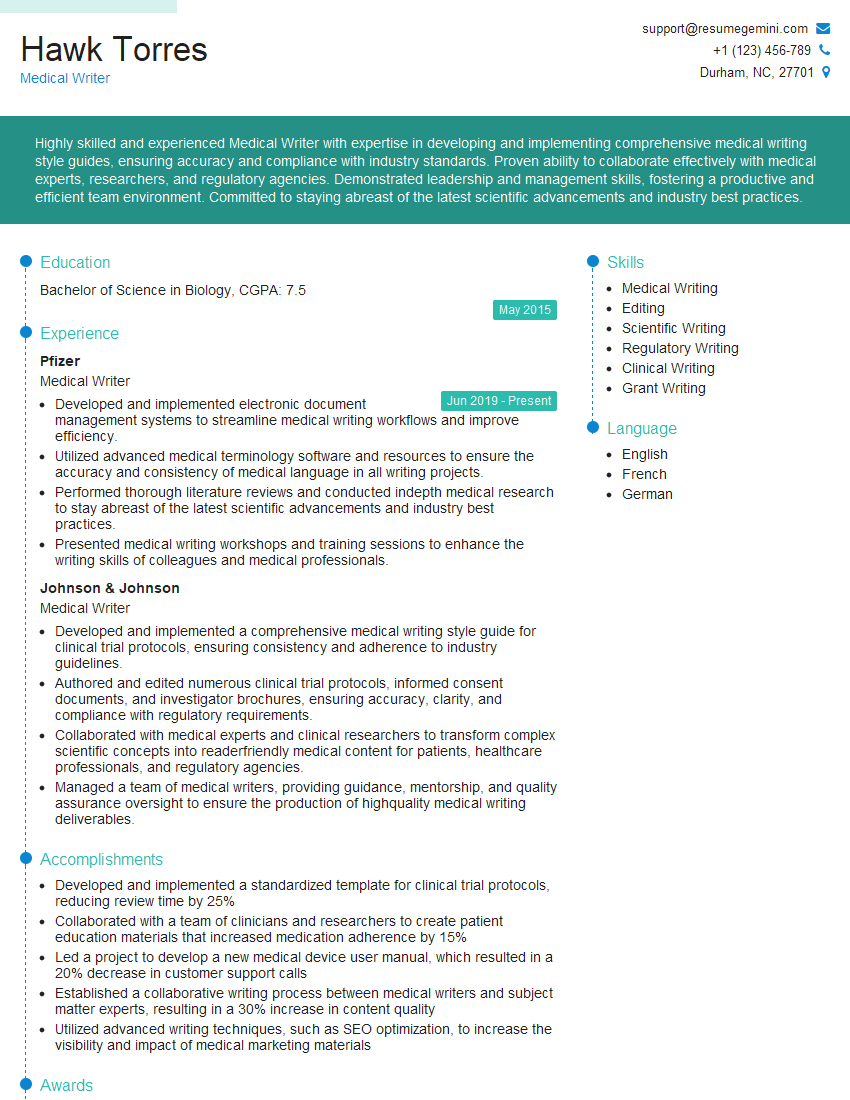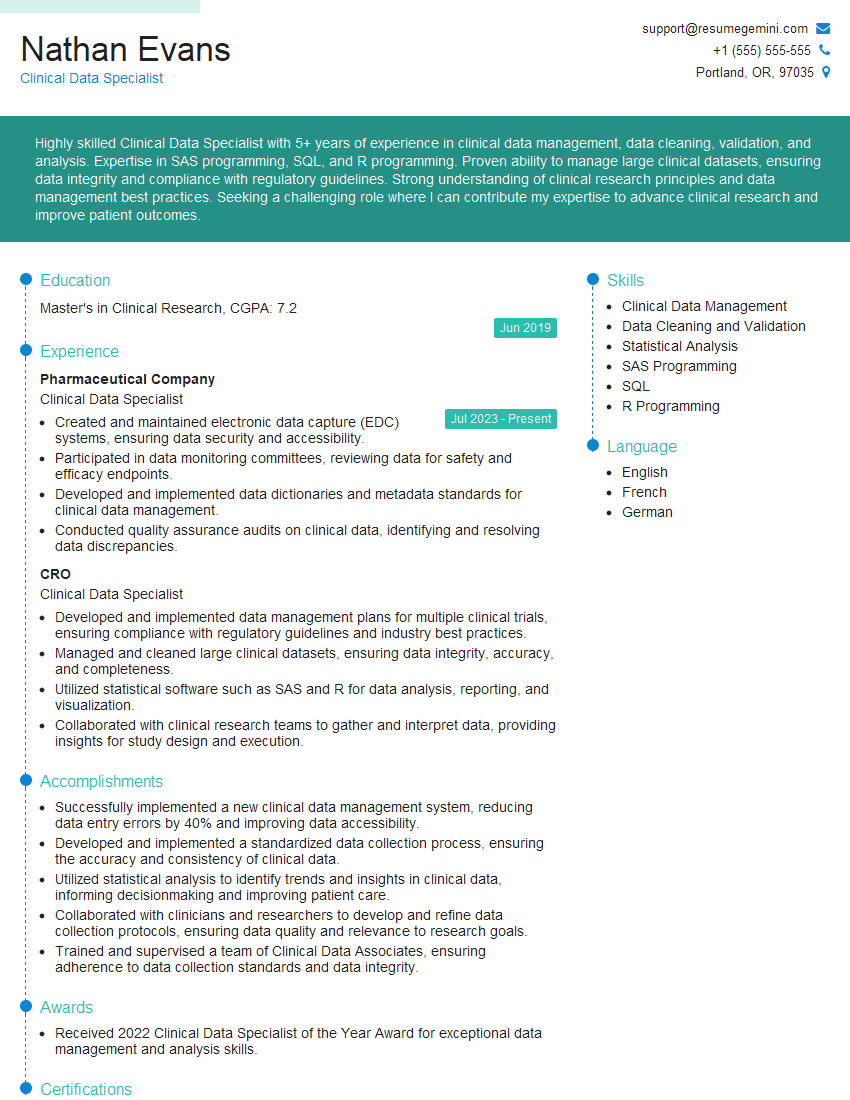Feeling uncertain about what to expect in your upcoming interview? We’ve got you covered! This blog highlights the most important Research and Clinical Trials Participation interview questions and provides actionable advice to help you stand out as the ideal candidate. Let’s pave the way for your success.
Questions Asked in Research and Clinical Trials Participation Interview
Q 1. Explain the phases of a clinical trial.
Clinical trials are conducted in phases, each with a specific objective. Think of it like building a house – you start with the foundation and gradually add complexity.
- Phase 0: This is an exploratory phase involving a very small number of participants. Its primary goal is to assess how a drug is processed in the body (pharmacokinetics) and how it interacts with the body’s systems (pharmacodynamics). It helps researchers determine if proceeding to further phases is worthwhile.
- Phase 1: Focuses on safety. A small group of healthy volunteers receive the treatment to evaluate safety, dosage tolerance, and potential side effects. This is where researchers determine a safe dosage range for larger studies.
- Phase 2: Assesses efficacy and further evaluates safety. A larger group of participants with the targeted condition receives the treatment to see if it works as intended and to identify optimal dosages. It’s about seeing if the treatment actually does what it’s supposed to do.
- Phase 3: A large-scale trial comparing the new treatment to a standard treatment or a placebo. It aims to confirm efficacy, monitor side effects, and compare it to existing therapies. This phase generates the data needed for regulatory approval.
- Phase 4: Post-market surveillance. This phase occurs after the drug is approved and on the market. It monitors long-term effects, rare side effects, and the efficacy of the drug in a larger, diverse population.
For example, a new cancer drug might go through these phases, starting with safety tests in a few volunteers, then moving to larger groups of cancer patients to see if it shrinks tumors, then finally comparing it to existing cancer treatments in a massive study before receiving regulatory approval.
Q 2. Describe the Good Clinical Practice (GCP) guidelines.
Good Clinical Practice (GCP) guidelines are a set of ethical and scientific quality requirements for designing, conducting, recording, and reporting clinical trials that involve human subjects. They ensure the rights, safety, and well-being of participants are protected, and that data generated is credible and reliable. Think of them as a comprehensive rulebook for conducting ethical and high-quality research.
- Ethical Considerations: Informed consent, confidentiality, and minimization of risk are paramount. Participants must understand the trial’s purpose, risks, and benefits before participating.
- Data Integrity: Accurate, complete, and verifiable data is essential. GCP provides guidelines for managing data, including proper documentation, record keeping, and audit trails.
- Protocol Adherence: Clinical trials must follow a detailed protocol that outlines every aspect of the study. Strict adherence ensures consistent data and minimizes bias.
- Regulatory Compliance: GCP guidelines align with international regulations and ethical standards set by organizations like the International Council for Harmonisation (ICH).
A failure to adhere to GCP could lead to unreliable results, regulatory penalties, and, most importantly, harm to participants.
Q 3. What is an Informed Consent Form (ICF) and its importance?
An Informed Consent Form (ICF) is a document that explains the details of a clinical trial to potential participants. It ensures participants voluntarily agree to participate, fully understanding the potential risks and benefits involved. It’s the cornerstone of ethical research involving humans.
- Key Elements: A clear description of the study’s purpose, procedures, risks, benefits, alternatives, and compensation (if any) must be included. The participant’s rights and responsibilities are also clearly defined.
- Voluntary Participation: Participants must understand they are free to withdraw from the trial at any time without penalty.
- Confidentiality: The ICF outlines how participant data will be protected and kept confidential.
- Contact Information: Contact information for the researchers and ethics committee is provided.
Without a properly signed ICF, participation in a clinical trial is unethical and potentially illegal. It ensures that participants make an informed and voluntary decision about their involvement.
Q 4. How do you handle deviations from a clinical trial protocol?
Deviations from a clinical trial protocol are unavoidable, but they must be documented and investigated meticulously. Imagine a recipe – a deviation is like changing an ingredient. You need to record what was changed and why, and assess if it affected the final result.
- Immediate Reporting: Any deviation, no matter how minor, must be immediately reported to the study team and documented in the case report forms (CRFs).
- Investigation: The cause of the deviation must be thoroughly investigated to understand why it occurred and to prevent future occurrences.
- Assessment of Impact: The potential impact of the deviation on the integrity of the study data must be evaluated. If the impact is significant, corrective actions may be necessary.
- Documentation: All deviations, investigations, and corrective actions must be meticulously documented and reviewed by the study monitor.
For instance, if a participant misses a scheduled visit, this is a deviation. The reason must be recorded, and the impact on the study’s results needs to be considered. This process ensures data accuracy and the overall integrity of the trial.
Q 5. Explain the different types of clinical trial designs.
Clinical trials can be designed in various ways, each suitable for different research questions. Choosing the right design is crucial for obtaining valid and reliable results.
- Randomized Controlled Trials (RCTs): Considered the gold standard, RCTs randomly assign participants to different treatment groups (e.g., new drug vs. placebo). This minimizes bias and helps determine the treatment’s true effect.
- Observational Studies: Researchers observe participants without intervening. These are useful for studying risk factors or the effectiveness of treatments in real-world settings. They are less controlled than RCTs.
- Parallel Group Design: Participants are randomly assigned to different treatment groups and are followed simultaneously.
- Crossover Design: Participants receive multiple treatments over time. Each participant serves as their own control, reducing the number of participants required.
- Factorial Design: Allows researchers to test the effects of multiple interventions simultaneously. This is efficient but can be complex to analyze.
For example, an RCT might be used to compare a new cholesterol medication to a standard one, while an observational study might investigate the association between smoking and lung cancer.
Q 6. What is blinding in a clinical trial, and why is it important?
Blinding, also known as masking, is a technique used to prevent bias in clinical trials. It involves concealing the treatment assignment (e.g., drug or placebo) from participants, researchers, or both. It’s like a magic trick, preventing those involved from knowing who got what treatment.
- Single-blind: Participants are unaware of their treatment assignment.
- Double-blind: Both participants and researchers are unaware of the treatment assignment.
- Triple-blind: Participants, researchers, and data analysts are unaware of treatment assignment.
Blinding is essential because it prevents bias from influencing outcomes. If participants know they’re receiving a placebo, they might report less improvement, and researchers might unconsciously interpret data differently if they know the treatment assignment. Blinding helps ensure that the observed effects are due to the treatment itself and not bias.
Q 7. How do you ensure data integrity in a clinical trial?
Data integrity in clinical trials is paramount. It means that the data collected is accurate, complete, consistent, and trustworthy. Maintaining data integrity is like building a strong, stable structure—any weakness compromises the whole.
- Data Collection Procedures: Clear, standardized procedures for data collection, using electronic data capture (EDC) systems whenever possible, reduce errors.
- Data Validation: Regular checks and validation of data throughout the trial to identify and correct any inconsistencies or errors.
- Audit Trails: Maintaining detailed audit trails of all data modifications and access to ensure accountability and transparency.
- Data Security: Implementing robust security measures to protect data from unauthorized access, modification, or loss.
- Data Monitoring: Regular monitoring of data by independent data monitoring committees (DMCs) to ensure data quality and safety.
For example, using a standardized case report form (CRF) with built-in data validation rules minimizes data entry errors. Regular audits and data monitoring help identify and correct errors before they affect the study’s conclusions.
Q 8. Describe your experience with electronic data capture (EDC) systems.
Electronic Data Capture (EDC) systems are software applications designed to collect and manage clinical trial data electronically. This eliminates paper-based CRFs (Case Report Forms) and streamlines the entire data management process. My experience spans over eight years working with various EDC systems, including Medidata Rave, Oracle Clinical, and Veeva Vault. I’m proficient in all aspects, from study build and user training to data validation and query resolution.
For example, in a recent Phase III oncology trial using Medidata Rave, I was responsible for building the study database, configuring data validation rules to ensure data integrity, and training site personnel on EDC system usage. This involved creating custom reports to monitor data completeness and identify potential issues early in the study, ultimately saving significant time and resources.
Another example involved resolving complex queries related to missing data or conflicting information. My analytical skills allowed me to efficiently identify the root cause of the discrepancies and collaborate with site investigators to ensure accurate data entry.
Q 9. What is your experience with regulatory submissions (e.g., IND, NDA)?
Regulatory submissions, such as Investigational New Drug (IND) applications and New Drug Applications (NDAs), are crucial steps in bringing new therapies to market. My experience involves working closely with regulatory affairs teams to prepare and submit these documents to agencies like the FDA (in the US) and EMA (in Europe). This includes contributing to the development of the clinical study reports (CSRs), which summarize the results of clinical trials and form a significant portion of the submission.
For instance, I was involved in the preparation of an NDA for a novel cardiovascular drug. This required meticulous review of the entire clinical data set, ensuring consistency and accuracy across all documentation. My understanding of regulatory requirements and guidelines, including ICH GCP, was instrumental in ensuring the submission met the highest standards of quality and completeness.
Q 10. How do you manage adverse events (AEs) in a clinical trial?
Managing Adverse Events (AEs) in a clinical trial is a critical aspect of ensuring patient safety. AEs are any undesirable medical occurrence in a patient or clinical trial participant administered a pharmaceutical product and/or other therapy, whether or not considered related to the study intervention. My approach involves a structured process: prompt reporting, thorough investigation, and careful documentation.
First, all AEs are reported by the investigator to the sponsor via the EDC system according to the protocol. Second, serious AEs (SAEs), which are those that are life-threatening, result in death, hospitalization, or disability/incapacity, are reported immediately. Third, causality assessments are performed to determine the likelihood that the AE was related to the study drug. This involves a careful review of the patient’s medical history, concomitant medications, and the timeline of events. Finally, all AEs and SAEs are meticulously documented in the CRF and tracked throughout the study.
Think of it like a detective investigating a crime; we need to gather all the evidence to determine if there’s a connection between the drug and the event. This process requires attention to detail and a clear understanding of regulatory guidelines.
Q 11. What is your experience with case report form (CRF) completion and review?
Case Report Forms (CRFs) are standardized documents used to collect data on individual participants in a clinical trial. My experience encompasses the entire CRF lifecycle: design, completion, and review. I’ve worked with various CRF designs, both paper-based and electronic, and I’m skilled in ensuring data quality through meticulous review and query resolution.
The design phase involves collaborating with clinical operations teams and statisticians to ensure data collected accurately addresses the study’s objectives. Completion involves monitoring data entry for completeness and accuracy; regularly checking for missing data, inconsistencies, and outliers. Review involves a rigorous process to identify and resolve discrepancies, clarifying ambiguous entries, and ensuring consistency throughout the dataset. Often this requires reaching out to investigators or study sites for clarification.
For example, I once identified a pattern of missing data on a specific CRF item across several sites. By investigating further, I discovered a flaw in the CRF design that made the data entry cumbersome. This finding allowed for improvements in subsequent studies, preventing similar problems in the future.
Q 12. Explain your understanding of ICH-GCP guidelines.
ICH-GCP (International Council for Harmonisation – Good Clinical Practice) guidelines provide a unified standard for designing, conducting, recording, and reporting clinical trials that involve the participation of human subjects. These guidelines are critical for ensuring the safety, integrity, and ethical conduct of clinical research.
My understanding of ICH-GCP encompasses all aspects, from the ethical considerations of informed consent to the meticulous documentation required for regulatory submissions. I understand the importance of adherence to these guidelines to protect the rights, safety, and well-being of participants, while also ensuring the credibility and reliability of clinical trial data. I have consistently applied these principles in all my clinical research activities, working to maintain the highest standards of quality and ethical conduct.
A practical example is implementing procedures for managing unblinding of trial participants or investigators in emergency situations—a critical aspect covered by ICH-GCP which needs careful management and documentation.
Q 13. How do you ensure patient safety in a clinical trial?
Ensuring patient safety is paramount in clinical trials. It’s not just a guideline; it’s a moral imperative. My approach is multi-faceted and starts well before the trial even begins.
Firstly, rigorous protocol development is crucial, incorporating safety monitoring plans and clearly defined criteria for adverse events. Secondly, a thorough informed consent process is essential, ensuring participants understand the risks and benefits involved. Thirdly, regular safety monitoring throughout the study is implemented, including ongoing review of AE data, lab results, and other safety parameters. This often involves employing specialized safety review boards. Finally, promptly reporting and investigating all safety concerns and having well-defined escalation procedures for serious issues is critical.
Imagine a patient experiencing an unexpected side effect – a quick and effective response is vital. This might involve immediate medical intervention, careful monitoring, or even study discontinuation, depending on the severity of the situation. Every decision must prioritize the patient’s well-being.
Q 14. What is your experience with data analysis in clinical trials?
Data analysis in clinical trials is a complex process requiring a combination of statistical expertise and a deep understanding of clinical research. My experience involves the entire data analysis process, from data cleaning and validation to statistical analysis and interpretation of results. I am proficient in using statistical software packages such as SAS, R, and SPSS.
For example, in a recent study, I performed descriptive statistics, survival analysis, and logistic regression to assess the efficacy and safety of a new treatment. This involved careful data cleaning to handle missing values and outliers, ensuring the accuracy and reliability of the results. The results were then presented in clear and concise reports, including tables and graphs, suitable for inclusion in publications and regulatory submissions.
Understanding the limitations of the data and properly interpreting statistical findings are critical for drawing meaningful conclusions. A key skill is communicating these complex findings to both technical and non-technical audiences, ensuring accurate and impactful dissemination of the research results.
Q 15. Describe your experience with audit preparation and responses.
Audit preparation involves meticulously reviewing all aspects of a clinical trial to ensure compliance with Good Clinical Practice (GCP) guidelines, regulatory requirements, and protocol specifications. This includes data integrity checks, source document verification, case report form (CRF) review, and assessment of the trial’s overall conduct. Responses require a detailed understanding of the audit findings, a well-documented explanation of any discrepancies, and a clear plan of corrective and preventative actions (CAPA).
In my experience, I’ve led multiple audit preparations, including those conducted by regulatory bodies like the FDA and EMA. One example involved an audit that flagged inconsistencies in data entry. By systematically analyzing the discrepancies, we identified a flaw in our data entry training program, immediately implementing a revised training protocol with enhanced quality control measures. We also created a robust tracking system for ensuring consistency in future data entries. This proactive approach not only addressed the immediate audit findings but also prevented similar issues from arising in the future. Successful responses involve not just addressing immediate issues but also proactively implementing systems to prevent recurrence, demonstrating a commitment to continuous improvement.
Career Expert Tips:
- Ace those interviews! Prepare effectively by reviewing the Top 50 Most Common Interview Questions on ResumeGemini.
- Navigate your job search with confidence! Explore a wide range of Career Tips on ResumeGemini. Learn about common challenges and recommendations to overcome them.
- Craft the perfect resume! Master the Art of Resume Writing with ResumeGemini’s guide. Showcase your unique qualifications and achievements effectively.
- Don’t miss out on holiday savings! Build your dream resume with ResumeGemini’s ATS optimized templates.
Q 16. How do you handle conflicts of interest in a clinical trial?
Conflicts of interest (COI) in clinical trials are any situation where a person’s personal interests could compromise their professional judgment or actions related to the trial. These can involve financial interests, personal relationships, or even intellectual property considerations. Handling COIs requires a proactive and transparent approach. This starts with disclosure – all individuals involved in the trial, from investigators to sponsors, must disclose any potential COIs. These disclosures are then reviewed by an independent ethics committee or COI review board to determine if the conflict is significant enough to warrant mitigation or exclusion from the trial. Mitigation strategies might involve removing the conflicted individual from certain aspects of the study or adding an additional oversight mechanism.
For instance, I once worked on a trial where a key investigator had a financial stake in a company that manufactured a competing drug. This was disclosed early, and the ethics committee deemed it a potential conflict. The solution involved adding a second, independent investigator to oversee data integrity and analysis, thereby ensuring objectivity and minimizing the potential for bias. Transparency and prompt action are paramount in effectively managing COIs to maintain the integrity of the trial and protect patient safety.
Q 17. What is your experience with budget management in clinical trials?
Budget management in clinical trials is critical. It requires careful planning, tracking, and analysis of expenses against the approved budget. This includes anticipating all costs, from investigator payments and site initiation visits to laboratory testing and data management. Effective budget management uses tools like budgeting software and regular financial reporting to identify and address any deviations from the plan. This prevents cost overruns and ensures that the trial stays within its allocated resources.
In my experience, I developed and managed budgets for several large-scale, multi-center clinical trials. We utilized a detailed line-item budget that tracked expenses at each site and for each activity. Regular monitoring allowed us to proactively identify and address potential budget overruns, for example by renegotiating contracts with vendors or identifying areas for cost savings without compromising data quality. We also ensured all expenses were properly documented and aligned with the trial’s protocol and regulatory requirements. Strong budget management is not merely about controlling costs but also ensuring that the trial has the necessary resources to succeed.
Q 18. Describe your experience with vendor management in clinical trials.
Vendor management in clinical trials is crucial because numerous vendors are typically involved, including CROs (Contract Research Organizations), labs, central imaging readers, and data management companies. Effective management involves selecting vendors based on their expertise, track record, and compliance with regulatory requirements. Ongoing monitoring of vendor performance is essential, encompassing quality control, timely delivery of services, and adherence to contractual obligations. This requires regular communication, performance evaluations, and clear service-level agreements (SLAs).
I’ve worked extensively with various vendors, negotiating contracts, establishing SLAs, and overseeing their performance. For example, during one trial, we experienced delays with a vendor responsible for central laboratory testing. Proactive communication and a detailed performance review led us to implement corrective actions including closer monitoring, enhanced communication, and ultimately, a switch to a more reliable vendor for specific tests. This process highlighted the importance of continuous monitoring and having clear mechanisms for addressing vendor performance issues.
Q 19. How familiar are you with different statistical methods used in clinical trials?
I am very familiar with a wide range of statistical methods used in clinical trials. These methods are essential for analyzing the data collected and drawing meaningful conclusions about the treatment’s efficacy and safety. Common methods include:
- Descriptive statistics: Summarizing data using measures like mean, median, standard deviation.
- Inferential statistics: Drawing conclusions about a population based on a sample, including hypothesis testing, confidence intervals, and regression analysis.
- Survival analysis: Analyzing time-to-event data, like time to progression or death.
- Analysis of variance (ANOVA): Comparing means across multiple groups.
- Mixed-effects models: Handling repeated measures data.
My experience includes utilizing these methods to design statistical analysis plans (SAPs), conduct analyses, interpret results, and prepare reports for regulatory submissions. Proficiency in statistical software packages like SAS, R, and SPSS is essential for this work.
Q 20. Explain the difference between efficacy and safety in clinical trials.
In clinical trials, efficacy refers to how well a treatment works in achieving its intended purpose – in other words, its positive effects. Safety, on the other hand, focuses on the potential risks and harms associated with the treatment. Both are crucial for determining whether a treatment is suitable for wider use. A treatment may be highly efficacious but unacceptable if it carries significant safety risks.
For example, a new cancer drug might demonstrate a high rate of tumor shrinkage (efficacy), but if it also causes serious heart problems (safety), its use would be carefully weighed against the risks. The balance between efficacy and safety is constantly evaluated throughout the clinical trial process, often involving careful consideration of benefit-risk ratios. Regulatory agencies place high importance on this balance when reviewing applications for drug approval.
Q 21. What is your experience with quality control in clinical trials?
Quality control (QC) in clinical trials encompasses all measures taken to ensure the data collected is reliable, accurate, and valid. This begins with the study design and extends through all phases of the trial, encompassing every aspect from subject recruitment and data collection to data analysis and reporting. QC practices involve regularly reviewing data for completeness, consistency, and accuracy, identifying and correcting errors, and implementing procedures to prevent future errors. This includes using standardized operating procedures (SOPs), regular audits, and appropriate training for all personnel.
In my experience, I’ve implemented and overseen QC procedures in various clinical trials. We used a multi-layered approach including data validation checks, source document verification, and regular audits to identify potential inconsistencies or errors. For instance, we implemented a system for regular data review where inconsistencies were flagged and addressed immediately, significantly improving data quality and reducing the risk of major errors. A robust QC program is critical for ensuring the integrity and reliability of trial data, ultimately affecting the accuracy of conclusions drawn from the research.
Q 22. How do you ensure compliance with regulations in clinical trials?
Ensuring compliance in clinical trials is paramount. It involves meticulous adherence to regulations like ICH-GCP (International Council for Harmonisation – Good Clinical Practice), FDA guidelines (in the US), and local regulations. This means implementing robust systems for data management, ensuring informed consent from participants, maintaining accurate records, and conducting audits to identify and rectify any deviations.
For example, we meticulously document every step of the trial, from protocol development to final report submission. This includes maintaining detailed case report forms (CRFs), managing adverse events diligently, and ensuring all interactions with participants are documented accurately. We regularly conduct internal audits and prepare for external audits by regulatory bodies, using a checklist system to ensure complete compliance. Failure to comply can result in serious consequences, including trial termination, fines, and reputational damage. Therefore, compliance is not just a requirement, but a cornerstone of ethical and scientifically sound research.
Q 23. Describe your experience with subject recruitment and retention.
Subject recruitment and retention are critical for successful trials. My experience involves developing and implementing comprehensive recruitment strategies, targeting specific demographics via various channels – from physician referrals and online advertising to community outreach programs and partnerships with patient advocacy groups.
To improve retention, I focus on building strong rapport with participants, providing clear and concise information, offering convenient study visit schedules, and addressing any concerns promptly and empathetically. For instance, in a previous trial, we noticed high attrition due to participant travel inconvenience. We addressed this by offering transportation assistance and arranging home visits where appropriate, significantly improving retention rates. Regular communication with participants, including text message reminders and personalized follow-ups, also played a crucial role. A robust system for tracking participant engagement and identifying potential attrition risks is also critical.
Q 24. What is your experience with clinical trial reporting?
Clinical trial reporting is a meticulous process, culminating in comprehensive documentation of the trial’s conduct and results. My experience encompasses all aspects, from generating interim reports to final study reports, adhering to regulatory guidelines (like ADaM – Analysis Data Model) for data presentation. This includes creating tables, listings, and figures (TLFs) that summarize key findings, conducting statistical analyses, and writing narrative reports that explain the results in a clear and concise manner.
For example, I’ve utilized software like SAS and R for data analysis and report generation. We also utilize reporting templates to maintain consistency and accuracy. A critical component is ensuring the integrity of the data and the transparency of the reporting process. Any deviations from the protocol or unexpected findings are thoroughly investigated and documented, ensuring a comprehensive and accurate representation of the trial’s results.
Q 25. How do you handle unexpected issues during a clinical trial?
Handling unexpected issues is an integral part of clinical trial management. My approach involves a structured process: first, assess the severity and potential impact of the issue. Is it a protocol deviation? An adverse event? A safety concern? Then, report it immediately through appropriate channels, escalating it to the appropriate committees (e.g., Data Safety Monitoring Board or DSMB) if necessary. Next, we initiate a thorough investigation, documenting findings and actions taken to mitigate the issue.
For example, if a serious adverse event occurs, we’ll immediately report it to relevant authorities and implement necessary safety measures. This may involve amending the protocol, providing additional training to study staff, or modifying the study procedures. Documentation is crucial throughout this process, ensuring a transparent and accountable response.
Q 26. What are your strengths and weaknesses in conducting clinical trials?
My strengths lie in my attention to detail, my ability to manage complex projects effectively, and my strong communication and interpersonal skills, essential for building relationships with investigators, participants, and regulatory bodies. My experience with statistical analysis and data interpretation contributes to robust trial reporting. I am proactive and solution-oriented, comfortable with ambiguity and readily adapt to changing circumstances.
One area for improvement is my delegation skills. While I can handle multiple tasks concurrently, I strive to refine my ability to effectively delegate to team members to optimize efficiency and leverage everyone’s strengths.
Q 27. How do you prioritize tasks in a fast-paced clinical trials environment?
Prioritization in a fast-paced clinical trial environment is crucial. I employ a combination of methods, including using project management tools (like Asana or Jira) to track tasks and deadlines. I also leverage risk assessment, prioritizing tasks based on their criticality and potential impact on the trial’s timelines and outcomes. This also involves frequently reviewing and readjusting priorities based on emerging challenges and changing circumstances.
I find it helpful to regularly communicate priorities to the team, ensuring everyone understands the critical path and their individual contributions. This collaborative approach encourages a shared sense of responsibility and efficiency. Additionally, I prioritize tasks that are time-sensitive, critical to participant safety, or directly related to regulatory compliance.
Q 28. Describe your experience working in a cross-functional team.
I thrive in cross-functional team environments. My experience includes working with diverse teams comprising statisticians, data managers, clinical monitors, regulatory specialists, and investigators. I effectively facilitate communication and collaboration among team members with different expertise and perspectives. This includes fostering open communication, promoting shared goals, and ensuring everyone feels valued and heard. I believe in leveraging each individual’s strengths and expertise to ensure the successful completion of the trial.
For instance, in one project, I successfully navigated disagreements between the statistical team and the regulatory team regarding data presentation by actively facilitating discussions, encouraging compromise, and presenting a unified, compliant solution.
Key Topics to Learn for Research and Clinical Trials Participation Interview
- Ethical Considerations in Research: Understand the principles of informed consent, patient autonomy, and data privacy within the context of clinical trials. Consider the practical application of these principles in resolving ethical dilemmas that may arise.
- Regulatory Compliance (e.g., GCP, ICH-GCP): Familiarize yourself with Good Clinical Practice guidelines and other relevant regulations. Be prepared to discuss how these regulations ensure the safety and integrity of clinical trials and how you would ensure compliance in a research setting.
- Study Design and Methodology: Grasp the different types of clinical trial designs (e.g., randomized controlled trials, observational studies) and their strengths and weaknesses. Be ready to discuss the practical application of choosing the appropriate design for a given research question.
- Data Management and Analysis: Understand the importance of accurate data collection, management, and analysis in clinical trials. Consider how to identify and address potential data inconsistencies or biases.
- Patient Recruitment and Retention: Explore the strategies and challenges involved in recruiting and retaining participants in clinical trials. Think about practical solutions to improve participation rates and minimize attrition.
- Adverse Event Reporting and Safety Monitoring: Learn about the processes for identifying, documenting, and reporting adverse events in clinical trials. Understand the importance of patient safety and how to effectively manage safety concerns.
- Statistical Concepts in Clinical Trials: Develop a fundamental understanding of statistical methods used in analyzing clinical trial data (e.g., hypothesis testing, confidence intervals). This is especially important for more technical roles.
Next Steps
Mastering the complexities of Research and Clinical Trials Participation is crucial for career advancement in this dynamic field. A strong understanding of these principles will significantly enhance your interview performance and open doors to exciting opportunities. To maximize your job prospects, it’s essential to create a compelling and ATS-friendly resume that effectively showcases your skills and experience. We highly recommend using ResumeGemini, a trusted resource for building professional resumes. ResumeGemini provides helpful tools and resources, and you’ll find examples of resumes tailored to Research and Clinical Trials Participation to guide you. This will help you present your qualifications in the best possible light.
Explore more articles
Users Rating of Our Blogs
Share Your Experience
We value your feedback! Please rate our content and share your thoughts (optional).
What Readers Say About Our Blog
This was kind of a unique content I found around the specialized skills. Very helpful questions and good detailed answers.
Very Helpful blog, thank you Interviewgemini team.
